Cooking beef with red peppers in a clay pot is a beautiful way to create a rich, flavorful dish that highlights the natural flavors of the ingredients. The slow cooking process helps tenderize the beef, allowing it to absorb the deep, savory flavors of the seasoning and the sweetness of the red peppers.
The clay pot’s unique properties ensure that the heat is evenly distributed, resulting in a perfectly cooked, juicy dish. Whether you’re preparing a hearty family dinner or looking for a new method to elevate your cooking, this technique will impress.
The combination of beef and red peppers brings together the savory richness of the meat with the bright, slightly sweet flavor of the peppers. When cooked together, the flavors meld harmoniously, creating a satisfying balance.
The clay pot adds an earthy undertone, further enhancing the overall experience. This cooking method is about the food and the experience of preparing a meal with care and tradition. So, let’s explore the steps and tips for cooking this delicious dish in a clay pot, and discover how simple ingredients can come together to create something truly special.
This recipe is adapted from The Cook’s Encyclopedia of One-Pot & Clay-Pot Cooking. Just for the record, this is my favorite cookbook for one-pot cooking, and there are plenty of great recipes for one-pot cooking with or without a clay pot.
What Is A Clay Pot and How Is It Used in Cooking?
A clay pot is a cookware made from natural, unglazed clay. It’s known for its ability to retain moisture and heat, which makes it ideal for slow-cooking methods. Here are some critical aspects of clay pots and their uses in cooking:
Characteristics of Clay Pots
- Material: Made from natural clay, these pots are often unglazed, allowing the food to interact directly with the clay.
- Heat Retention: Clay pots heat up slowly and retain heat well, providing even cooking temperatures.
- Moisture Retention: The porous nature of clay allows it to absorb water, which it then releases slowly during cooking, keeping food moist.
- Flavor Enhancement: Some cooks believe the interaction between the clay and the food can enhance flavors, making dishes taste more prosperous and complex.
Types of Clay Pots
- Earthenware Pots: These are basic, unglazed pots often used for traditional cooking.
- Tagines: Originating from North Africa, these pots have a distinctive conical lid that helps return condensed steam to the dish.
- Roman Pots are typically soaked in water before use and designed to create a steam cooking environment.
- Chinese Clay Pots: Often used for dishes like braised meats and soups, they have a glazed interior to prevent sticking.
Uses in Cooking
- Stews and Braises: Clay pots are perfect for slow-cooking stews and braises. The steady, even heat breaks down tough meat fibers and melds flavors over time.
- Rice and Grains: Cooking rice and other grains in a clay pot can enhance their texture and flavor.
- Baking: Some bread and cakes can be baked in clay pots, benefiting from the even heat distribution.
- Vegetables: Roasting vegetables in a clay pot can enhance their natural sweetness and retain moisture.
Cooking Tips
- Soaking: Many clay pots must be soaked in water before use to prevent cracking and create a moist cooking environment.
- Heating: Clay pots should be heated gradually. Start with a low flame or temperature and increase gradually to prevent cracking.
- Cleaning: Avoid using soap as the porous clay can absorb it, affecting the flavor of future dishes. Use hot water and a brush instead.
- Seasoning: Some clay pots require seasoning before first use. This involves coating the pot with oil and baking it to create a protective layer.
Cultural Uses
- Indian Cooking: Clay pots, called “handis,” are used for slow-cooked curries and biryanis.
- Mexican Cooking: Clay pots, known as “ollas,” make beans, stews, and moles.
- Mediterranean Cooking: Tagines and other clay vessels are used for making flavorful, aromatic stews.
Using a clay pot in cooking can impart unique textures and flavors to food, making it a cherished tool in many culinary traditions.
Advantages of Cooking in a Clay Pot
Cooking in a clay pot offers several advantages that can enhance your food’s taste, texture, and nutritional value. Here are some of the key benefits:
1. Enhanced Flavor
- Natural Material: The porous nature of clay allows it to interact with food, enhancing flavors and creating a unique, earthy taste.
- Moisture Retention: The slow moisture release from the clay keeps food juicy and tender, concentrating and enhancing flavors over time.
2. Even Heat Distribution
- Gradual Heating: Clay pots heat up slowly and distribute heat evenly, preventing hot spots and ensuring that food cooks uniformly.
- Consistent Temperature: Clay’s heat retention properties help maintain a steady cooking temperature, ideal for slow-cooking recipes.
3. Nutritional Benefits
- Reduced Need for Fats and Oils: Clay pots’ moisture-retentive properties mean you can use less oil or fat to cook, making meals healthier.
- Nutrient Preservation: Slow cooking at lower temperatures helps preserve food’s nutritional content, including vitamins and minerals.
4. Versatility
- Multi-purpose Use: Clay pots can be used for various cooking methods, including baking, roasting, stewing, and steaming.
- Cultural Versatility: Clay pots are used in many traditional cuisines worldwide, allowing you to explore diverse cooking styles and dishes.
5. Health Benefits
- Chemical-Free Cooking: Unlike some modern cookware, clay pots are free from harmful chemicals and synthetic materials, providing a natural cooking environment.
- Alkaline Cooking: Clay pots can help balance foods’ acidity, making them more alkaline and easier to digest.
6. Moisture Retention
- Hydrated Cooking Environment: Clay’s porous nature allows it to absorb and release moisture, keeping food moist and preventing it from drying out.
- Perfect for Slow Cooking: Dishes that require long cooking times, such as stews, soups, and braises, benefit from the gentle and moist cooking environment of a clay pot.
7. Energy Efficiency
- Retains Heat: Once heated, clay pots retain heat for a long time, allowing you to cook at lower temperatures and use less energy.
- Gradual Cooling: The slow cooling process of clay pots means you can turn off the heat before the cooking is done, and the residual heat will finish the job.
8. Aesthetic Appeal
- Traditional Look: Clay pots add a rustic charm to your kitchen and dining table.
- Serving and Presentation: Many clay pots are attractive enough to go from the oven to the table, making for a beautiful presentation.
9. Eco-Friendly
- Sustainable Material: Clay is a natural, renewable resource, and clay pots are biodegradable, making them an environmentally friendly choice.
Don’t Use the Clay Pot for Browning
This recipe calls for browning the beef before cooking it in the clay pot. However, using an unglazed clay pot on top of a stove is not recommended because it is extremely sensitive to sudden changes in temperature.
You’ll be better off browning the meat, sautéing the vegetables in a large saute pan, and letting them cool before adding them to a cold clay pot. So let us call this two-pot cooking, but it is still a great method for cooking lean or tough cuts of meat.
This method of cooking is very similar to Pan Roasting. To learn more about clay pots and why they are so much fun to cook with, go to Clay Pot Cooking.
What is a bouquet garni?
It is a little bundle of herbs tied together or placed in a piece of cheesecloth, used to enhance the flavor of a soup or stew. The classic combination of herbs is parsley, thyme, and bay leaf.
Serving Alternative
We like to plate the food before serving it to our guests. This way, we have better control of the portions, and everyone will surely get an equal amount.
If I make a mistake and don’t prepare enough of one ingredient, I can fix it by distributing it as best I can.
Clay-Pot Beef with Red Peppers
Ingredients
- 2 1/2 pound rump roast or bottom round
- 2 cloves garlic
- 2 teaspoons sunflower oil you can substitute olive or canola oil
- 1 large yellow onion
- 1¼ cups beef stock
- 1 teaspoon tomato paste
- ⅔ cup red wine
- bouquet garni see below
- 4 red peppers
- 1 tablespoon butter
- 1 teaspoon all purpose flour
- salt and freshly ground pepper to taste
Instructions
- Start by soaking the clay pot in cold water for at least 20 minutes, then drain.
- Cut the garlic cloves into thin slivers. These will be inserted into the beef for added flavor.
- The onion needs to be diced and a bouquet garni needs to be prepared.
- The red bell peppers need to be halved lengthwise and seeded. Be sure to remove the ribbing.
- You are going to make a thickener with the butter and flour which is called a beurre manie. It is easier to work with when the butter is soft so take out the butter now and let it sit until soft. If you have to heat it up a little in a pan or in the microwave.
- Using a paring knife, make a bunch of small incisions throughput the meat and insert the garlic slivers into them.
- Season the meat with salt and pepper on all sides.
- Heat a large heavy bottomed pan over medium high heat, add the oil and let it get hot. You want the oil to heat up just to the point of smoking. No more.
- Now add the beef and brown on all sides. Remove it from the pan and set aside uncovered.
- Add the onion to the pan and saute the onions until golden. Remove the onions from the pan and transfer to the clay pot.
- Put the beef on top of the onions and get the beef stock ready.You do this by combining the stock, tomato puree and wine together in a bowl and then pour it over the beef in the clay pot.
- Add the bouquet garni to the clay pot, cover and place in the COLD oven. We don't want to preheat the oven when using a clay pot. Remember, a cold clay pot does not do well with extreme temperature changes.
- Crank up the oven to 400° F and cook for 1 hour.
- Remove the cover from the clay pot, baste, add the bell pepper halves and continue cooking uncovered for about 45 minutes or until the beef is tender.
Making the Sauce
- Remove the meat, peppers and onions from the pot and reserve them on a large serving dish.
- Pour off the liquids from the clay pot into a sauce pan and heat over medium heat. This one-pan cooking just turned into three pans. You can always use the pan you browned the meat in but I think it is better to work in a sauce pan.
- Blend together the flour and butter in a small dish to make a paste. Slowly and in small spoonfuls, add the flour butter combination to the reserved liquid. What we are trying to do is thicken the sauce.
- Raise the heat to medium high and bring the sauce to a boil. Immediately lower the heat and simmer the sauce until it is thick enough to coat a spoon. Be sure to stir or whisk the sauce during the process or it will burn.
- When the sauce is at the consistency to your liking, pour it into gravy boat and serve it with the beef.

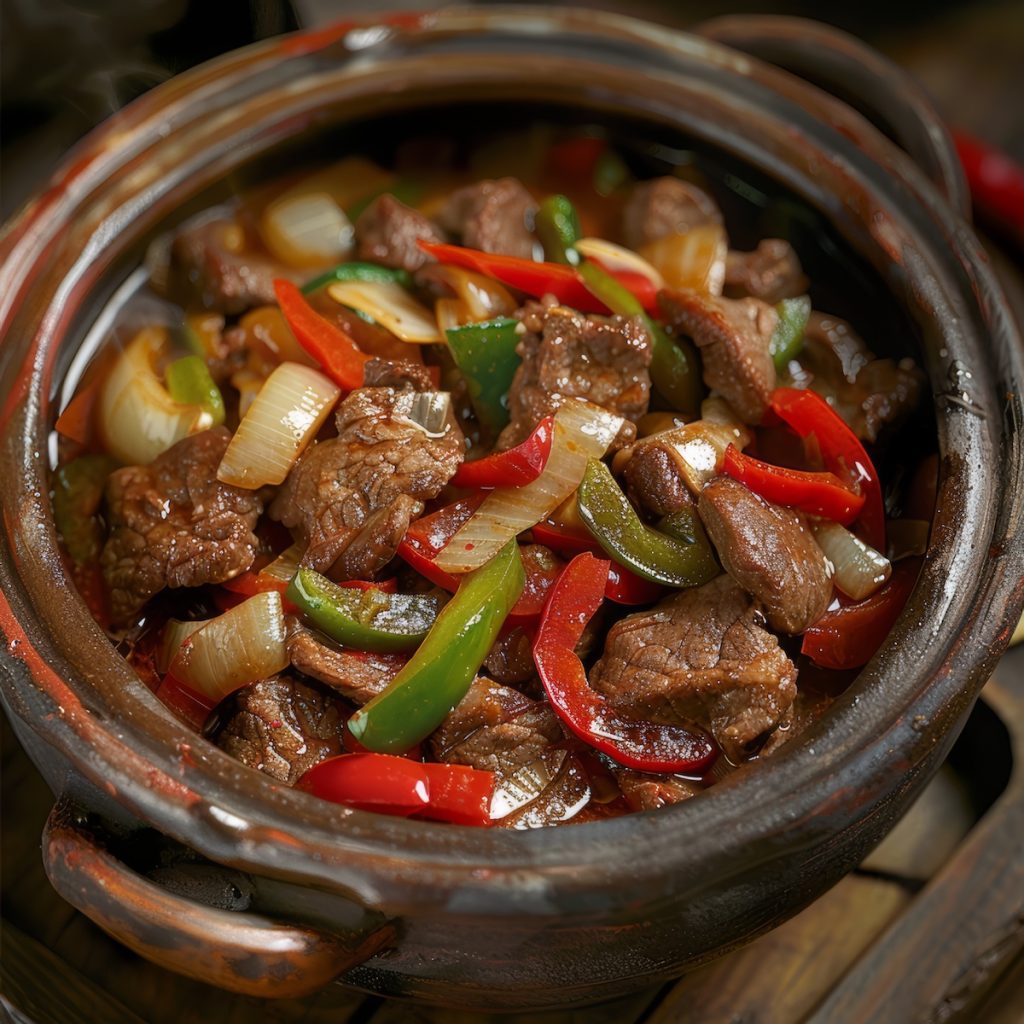
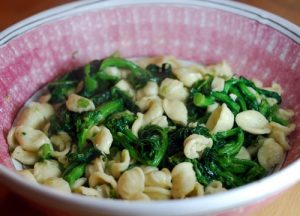
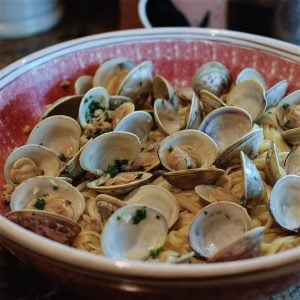


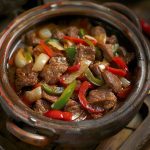

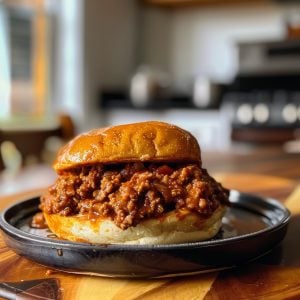
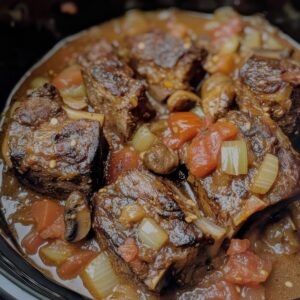
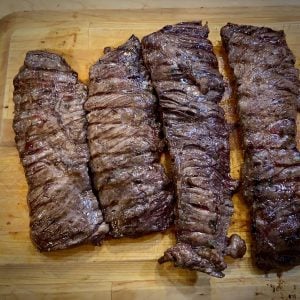
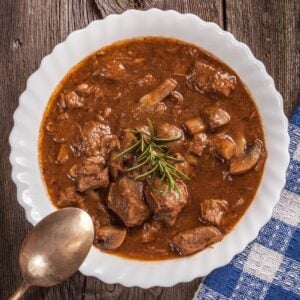
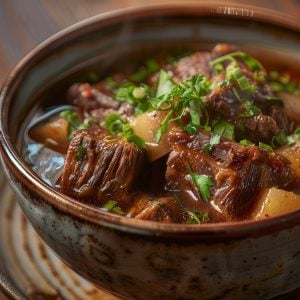
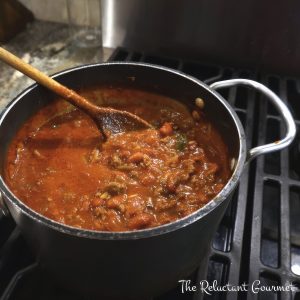
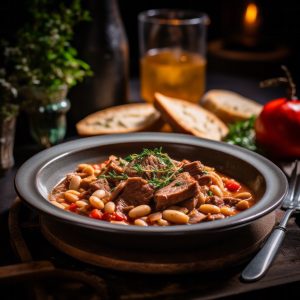


4 Responses
Please could you inform me where i could purchase a clay pot for one. Much appreciated
Paul Mylam
I was able to get one a a grocery store which sells a lot of Mexican food.
I was very excited about making this, but the result was quite disappointing. Typically food cooked in a clay pot is very moist and tender. The beef (which was of good quality) was rather dry and tough. The gravy, though, was excellent. I am unlikely to make this again.
The Costco Business Centre in Edmonton has 2 sets of beautiful Clay Cooking Pots on sale. Regularly 189.00. Now 79.00.They are beautiful as well.